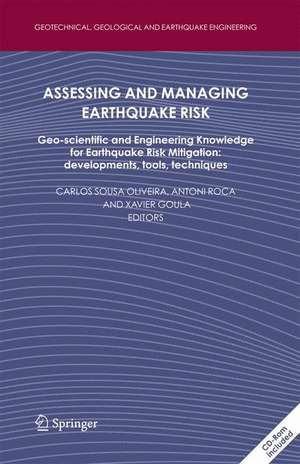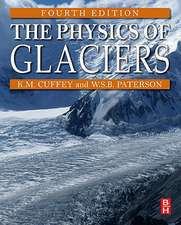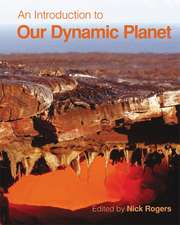Assessing and Managing Earthquake Risk: Geo-scientific and Engineering Knowledge for Earthquake Risk Mitigation: developments, tools, techniques: Geotechnical, Geological and Earthquake Engineering, cartea 2
Editat de Carlos Sousa Oliveira, Antoni Roca, Xavier Goulaen Limba Engleză Hardback – dec 2005
| Toate formatele și edițiile | Preț | Express |
|---|---|---|
| Paperback (1) | 1229.73 lei 6-8 săpt. | |
| SPRINGER NETHERLANDS – 27 noi 2014 | 1229.73 lei 6-8 săpt. | |
| Hardback (1) | 1242.83 lei 6-8 săpt. | |
| SPRINGER NETHERLANDS – dec 2005 | 1242.83 lei 6-8 săpt. |
Din seria Geotechnical, Geological and Earthquake Engineering
- 15%
 Preț: 665.73 lei
Preț: 665.73 lei - 18%
 Preț: 1405.90 lei
Preț: 1405.90 lei - 15%
 Preț: 717.59 lei
Preț: 717.59 lei - 18%
 Preț: 959.19 lei
Preț: 959.19 lei - 15%
 Preț: 656.43 lei
Preț: 656.43 lei - 18%
 Preț: 1944.11 lei
Preț: 1944.11 lei -
 Preț: 392.60 lei
Preț: 392.60 lei - 18%
 Preț: 954.62 lei
Preț: 954.62 lei - 18%
 Preț: 954.45 lei
Preț: 954.45 lei - 15%
 Preț: 638.24 lei
Preț: 638.24 lei - 18%
 Preț: 954.45 lei
Preț: 954.45 lei - 15%
 Preț: 640.24 lei
Preț: 640.24 lei - 20%
 Preț: 572.65 lei
Preț: 572.65 lei - 24%
 Preț: 805.40 lei
Preț: 805.40 lei - 20%
 Preț: 602.78 lei
Preț: 602.78 lei - 15%
 Preț: 639.08 lei
Preț: 639.08 lei - 15%
 Preț: 639.73 lei
Preț: 639.73 lei - 15%
 Preț: 637.46 lei
Preț: 637.46 lei - 18%
 Preț: 1222.01 lei
Preț: 1222.01 lei - 18%
 Preț: 967.08 lei
Preț: 967.08 lei - 18%
 Preț: 959.98 lei
Preț: 959.98 lei - 15%
 Preț: 658.88 lei
Preț: 658.88 lei - 18%
 Preț: 969.44 lei
Preț: 969.44 lei - 15%
 Preț: 653.79 lei
Preț: 653.79 lei - 15%
 Preț: 657.73 lei
Preț: 657.73 lei - 18%
 Preț: 961.55 lei
Preț: 961.55 lei - 15%
 Preț: 652.49 lei
Preț: 652.49 lei - 18%
 Preț: 961.86 lei
Preț: 961.86 lei - 15%
 Preț: 649.06 lei
Preț: 649.06 lei -
 Preț: 450.02 lei
Preț: 450.02 lei - 18%
 Preț: 967.22 lei
Preț: 967.22 lei - 18%
 Preț: 1117.99 lei
Preț: 1117.99 lei - 15%
 Preț: 656.58 lei
Preț: 656.58 lei
Preț: 1242.83 lei
Preț vechi: 1515.65 lei
-18% Nou
Puncte Express: 1864
Preț estimativ în valută:
237.85€ • 247.40$ • 196.36£
237.85€ • 247.40$ • 196.36£
Carte tipărită la comandă
Livrare economică 14-28 aprilie
Preluare comenzi: 021 569.72.76
Specificații
ISBN-13: 9781402035241
ISBN-10: 1402035241
Pagini: 572
Ilustrații: XXV, 545 p.
Dimensiuni: 155 x 235 x 36 mm
Greutate: 1.17 kg
Ediția:2006
Editura: SPRINGER NETHERLANDS
Colecția Springer
Seria Geotechnical, Geological and Earthquake Engineering
Locul publicării:Dordrecht, Netherlands
ISBN-10: 1402035241
Pagini: 572
Ilustrații: XXV, 545 p.
Dimensiuni: 155 x 235 x 36 mm
Greutate: 1.17 kg
Ediția:2006
Editura: SPRINGER NETHERLANDS
Colecția Springer
Seria Geotechnical, Geological and Earthquake Engineering
Locul publicării:Dordrecht, Netherlands
Public țintă
Professional/practitionerCuprins
Assessing and Managing Earthquake Risk. An Introduction.- Assessing and Managing Earthquake Risk. An Introduction.- Earthquake Hazard And Strong Motion.- Overview on Earthquake Hazard Assessment - Methods and New Trends.- Observation, Characterization and Prediction Of Strong Ground Motion.- Local Site Effects and Microzonation.- Site-City Interaction.- Vulnerability Assessment.- Vulnerability Assessment Of Dwelling Buildings.- Vulnerability Assessment Of Historical Buildings.- Experimental Techniques For Assessment Of Dynamic Behaviour Of Buildings.- Vulnerability and Risk Assessment Of Lifelines.- System Analysis And Risk.- Damage Scenarios and Damage Evaluation.- Urban System Exposure to Natural Disasters: An Integrated Approach.- Response Of Hospital Systems.- Managing Earthquake Risk.- Building Against Earthquakes.- Industrial Facilities.- Early Warning and Rapid Damage Assessment.- Technical Emergency Management.- Civil Protection Management.- Earthquake Risk and Insurance.- Strengthening and Repairing Earthquake Damaged Structures.- Advanced Techniques in Modelling, Response and Recovery.- Case Studies, Initiatives And Experiences.- Seismic Loss Scenarios Based on Hazard Disaggregation. Application to the Metropolitan Region of Lisbon, Portugal.- Loss Scenarios For Regional Emergency Plans: Application to Catalonia, Spain.- Risk-Ue Project: An Advanced Approach to Earthquake Risk Scenarios With Application to Different European Towns.
Textul de pe ultima copertă
This book points out the need of a multidisciplinary approach in the field of risk assessment and management. It provides an overview of the problems, approaches and common practices directly related to earthquake risk mitigation and, in particular, to the preparation of earthquake emergency plans. Written by a team of specialists from different disciplines, the authors worked together extensively in order to create unity and continuity in the text as a whole. Each topic is illustrated with examples of actual applications taken from the bibliography – including websites with available relevant information. Case studies and information on some relevant international projects are given.
Audience
This work will be of interest to students and professionals with a basic education in geology, geophysics, geotechnical and civil engineering, system analysis, geography and architecture. It can be used as a textbook for a specialized post-graduate course on the topic.
Audience
This work will be of interest to students and professionals with a basic education in geology, geophysics, geotechnical and civil engineering, system analysis, geography and architecture. It can be used as a textbook for a specialized post-graduate course on the topic.
Caracteristici
Multidisciplinary approach of risk assessment and management, which can provide more efficient earthquake mitigation Transfer of Geo-scientific and engineering knowledge to Civil Protection and insurance agents Approaches and common practices directly related to the preparation of earthquake emergency plans Illustrated examples of actual applications, including web sites Case studies and information on relevant international projects
















